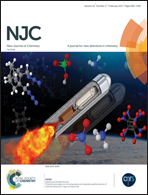Superamphiphobic aluminum surfaces that maintain robust stability after undergoing severe chemical and physical damage†
Abstract
This work demonstrated a simple, effective and economic method to fabricate robust superamphiphobic aluminum surfaces that showed super-repellency even towards very low-surface-tension liquids, including octane with a surface tension of 21.7 mN m−1. The dual microstep/nanopore structures were firstly constructed through combining chemical etching, anodization, and a subsequent pore-widening treatment. The pore-widening time that controlled the pore size and porosity determined the surface oil-repellent ability. With an appropriate pore-widening time, these nanopores broke down and were over-etched, and ultimately turned into large-area nanowire arrays. The hierarchical microstep/nanowire array architecture, when modified with fluorosilane, finally made the surface realize superamphiphobicity towards octane. The surface wettabilities of the hierarchical-nanopore structure and hierarchical-nanowire array structure towards various oils were investigated and compared in detail. More importantly, the final superamphiphobic surfaces simultaneously presented robust stabilities and high resistances to severe chemical and physical damage. The hierarchical-nanowire surfaces were able to repel strong HCl/NaOH solutions (25 °C), hot solutions (water, HCl/NaOH solutions, 30–100 °C), and even 98% concentrated H2SO4. Furthermore, when the surfaces were submerged in NaCl solution for 48 h, exposed in a thermal atmosphere (280 °C for 4 h), immersed in solvent, and stored under air conditions for 8 months, the super-liquid-repellency of the surfaces remained unchanged. They impressively sustained their superamphiphobicity after intensive scratching with an incisive blade, contaminated finger-contact, multiple bending to 180°, repeated peeling tests by adhesive tape, and reciprocating abrasion treatment under 500 g of force. The superior stability of the superamphiphobic surfaces is attributed to their stable surface structure and composition, and is believed to broaden their outdoor applications.



 Please wait while we load your content...
Please wait while we load your content...